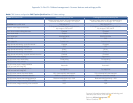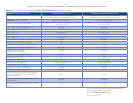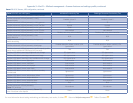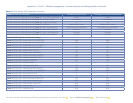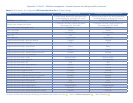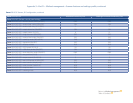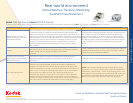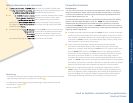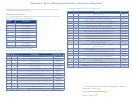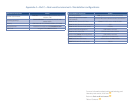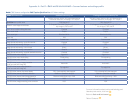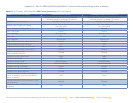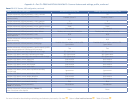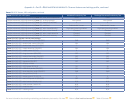
Testing observations and conclusions
Operators of the
Operators of the
Canon
DR-X10C Scanner must be constantly vigilant when
DR-X10C Scanner must be constantly vigilant when
preparing documents for scanning, completing more extensive presorting, or risk
preparing documents for scanning, completing more extensive presorting, or risk
preparing documents for scanning, completing more extensive presorting, or risk
ongoing misfeeds along with associated downtime and productivity.
ongoing misfeeds along with associated downtime and productivity.
ongoing misfeeds along with associated downtime and productivity.
The
Canon
Canon
DR-X10C Scanner creates potential confusion because with misfeed
DR-X10C Scanner creates potential confusion because with misfeed
retry mechanism engaged, operator must respond to scanner control panel
retry mechanism engaged, operator must respond to scanner control panel
retry mechanism engaged, operator must respond to scanner control panel
messaging as well as resolve any discrepancy between physical document
messaging as well as resolve any discrepancy between physical document
messaging as well as resolve any discrepancy between physical document
output and electronic images saved at the host to discover if these were the
output and electronic images saved at the host to discover if these were the
output and electronic images saved at the host to discover if these were the
only images “missed.” Occurrences of this scenario during testing diminished
only images “missed.” Occurrences of this scenario during testing diminished
only images “missed.” Occurrences of this scenario during testing diminished
productivity significantly.
productivity significantly.
No matter how much dust is introduced to the
No matter how much dust is introduced to the
No matter how much dust is introduced to the
Canon
DR-X10C Scanner during
a job, dust detection software will not be induced to stop/check/clear the dust
a job, dust detection software will not be induced to stop/check/clear the dust
a job, dust detection software will not be induced to stop/check/clear the dust
automatically. Only when the operator intervenes will dust be cleared at this
automatically. Only when the operator intervenes will dust be cleared at this
automatically. Only when the operator intervenes will dust be cleared at this
point. Streaking on images was visible during the running of a batch, with auto
point. Streaking on images was visible during the running of a batch, with auto
point. Streaking on images was visible during the running of a batch, with auto
dust removal not being activated until a new batch was initiated.
dust removal not being activated until a new batch was initiated.
dust removal not being activated until a new batch was initiated.
Competitive knockouts
Key takeaways:
The real world of scanning is not a perfect world. Mixed sizes, shapes, and weights—
along with attachments, staples, colors, folds and other common issues—occur daily.
To achieve true productivity, variables must be accounted for and handled with ease
to ensure robust performance. The
Kodak
i780 Scanner delivers reliable productivity
Kodak i780 Scanner delivers reliable productivity Kodak
at rated speeds day after day, thanks to a combination of speed, productivity building
features, and robust paper handling. In tests, the
Kodak
i780 Scanner seamlessly
Kodak i780 Scanner seamlessly Kodak
handled mixed document batches and avoided the types of productivity issues that
encumbered the
Canon
DR-X10C Scanner. The
Canon
Scanner arrives with a variety of
troublesome design elements that slash productivity, create headaches and hassles, and
negatively impact image quality.
Divergent document batches befuddle the
Canon
DR-X10C Scanner. Envelopes,
checks and varied sizes throttle the scanner’s throughput, unless the “misfeed
retry” feature is turned o. Batches with a wide range of document types and
sizes send the
Canon
Scanner into misfeed detect/rapid recovery mode, which
reduced productivity in side-by-side testing.
4
Canon claims exclusive paper-feeding technology that easily handles
documents of the widest range of sizes, weights and types to deliver high
productivity. However, when testing the
Canon
DR-X10C Scanner side-by-side
with the
Kodak
i780 Scanner, the
Canon
Scanner’s retry feeding mechanism
slows down overall throughput as it detects false double feeds when common
document types are fed. Kodak’s CCD sensors track every page, check for
overlaps and misfeeds, and help deliver outstanding image quality at full rated
speed. The
Kodak
i780 Scanner is not fooled by adhesive labels or varying paper
thicknesses, and requires no operator calibration to optimally handle the widest
variety of document types and thicknesses as defined in its specifications.
Dust can be a significant problem (for cleaning and image quality) with the
Canon
Scanner, as a questionable design for detecting and clearing dust may
allow it to negatively impact image quality while setting false expectations for
dust-free imaging with customers. Kodak’s exceptional sensor and transport
technologies and design eectively minimize quality issues due to dust.
Competitive BenChmarking
Count on Kodak for consistent and true performance.
Count out Canon.
Methodology
4
For detailed information about testing methodology used in real-world environment
paper handling and productivity scenarios, click here
➡
5
For detailed information about testing methodology results related to dust and
contaminants, click here
➡
Table of Contents
➡




